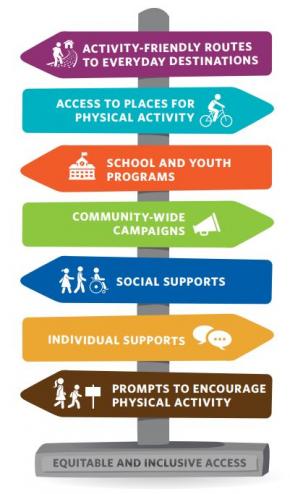October 23, 2019
Let’s Play: Bringing Youth Sports to Activity-Friendly Communities
School is in session and fall is upon us. For some families, that also means resuming physical activities, such as sports. I remember shuttling my own children to practices and games, making sure they had their uniforms, water bottles, and gear for the many different sports they played. I also encouraged them to be active outside of sports and to walk and bike to school. As I look back, I realize how lucky we were to live in a community and school system that provided so many opportunities for my kids to stay active.
The benefits of regular physical activity are indisputable. Kids who are physically active have less depression, perform better in school, and decrease their risks of developing chronic diseases later in life, among many benefits.
Approximately 74% of high school students do not get the recommended 60 minutes of daily physical activity they need to stay healthy.
Youth sports is one way for kids to be more active. Sports can play an important role in the health and development of kids. Unfortunately, too many kids either don’t play or stop playing sports. There can be several reasons for this: kids may lack access to equipment or safe places to play sports, they may have limited interest in or time for sports, or they may face prohibitive costs of participating in sports.
All of us have a part to play in making sports more accessible and fun. By working together, we can make improvements to the places where young people spend their time—at home, in schools, and in our communities—so that parents and youth of all backgrounds can be part of the fun.
Joining Forces: The National Youth Sports Strategy
The National Youth Sports Strategy, released by the U.S. Department of Health and Human Services, outlines steps that all of us can take to ensure youth have the opportunity, motivation, and access to play sports.
The report places special emphasis on underserved populations, including girls, racial and ethnic minorities, youth from households of low socioeconomic position, youth living in rural areas, and youth with disabilities. It also highlights the important role schools and communities can play to increase access to youth sports.
Below are just a few actions youth, adults, schools, and communities can take:
How to Increase Participation in Youth Sports
Youth can:
- Learn about the benefits of playing sports, as well as opportunities to play.
- Play a variety of sports to build physical literacy and find enjoyable activities.
- Ask parents or caregivers to sign them up for sports teams or activities.
Adults can:
- Make having fun a primary focus of sports activities.
- Encourage playing more than one sport throughout the year.
- Promote physical literacy* as a foundation for sports programs.
Schools can:
- Embrace a sports-for-all mentality and offer programs that are inclusive, culturally appropriate, and accessible
- Develop partnerships across a variety of sectors, including education, faith-based, media, technology, community recreation, public health, and business
- Consider the location of sports programs and transportation options to ensure safe and inclusive access.
Communities can:
- Develop shared-use agreements to increase access to sports facilities at schools and within the community.
- Locate sports facilities in areas that are safe and accessible via multiple transportation options.
- Promote the benefits of and access to sports opportunities to youth and their families.
Active People, Healthy NationSM: Creating an Active America, Together
Sports can help kids stay active. Kids can also become more active through other opportunities offered in their schools and communities.
CDC’s Division of Nutrition, Physical Activity, and Obesity works in collaboration with CDC’s Healthy Schools Program to increase physical activity among all youth in America. As part of this work, we launched a new initiative called Active People, Healthy NationSM to help 27 million Americans—including 2 million youth—be more physically active.
Active People, Healthy NationSM promotes seven strategies to increase physical activity in adults and youth. Carrying out these strategies can help youth have access to:
• sidewalks and safe streets for walking and biking,
• quality physical education programs,
• safe places in their community to be active, such as parks,
• programs that help those with different levels of ability be active.
Cross-sector collaboration is key to the success of Active People, Healthy NationSM. People and organizations from a variety of sectors—health, education, transportation, business, and more—can come together to fast-track progress, sustain improvements in physical activity, and ensure all Americans have an opportunity to reach their full potential.
I invite you to visit the Active People, Healthy NationSM website and email us at [email protected] to receive more information.
By working together across communities and organizations such as the Alliance for a Healthier Generation, we can help reduce barriers to youth physical activity.
We all deserve to send our kids to schools and live in communities that provide opportunities for all youth to be physically active.


